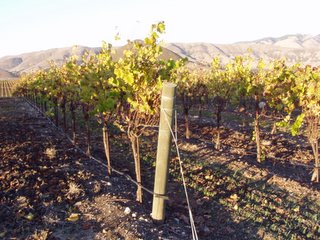
"I think the average person should be more interested in microbes, because it is good to know who is running your world..." -Ignacio Chapella, in "Intimate Strangers"
- For every unit of animal mass in soil (insects, worms, gophers, etc...) there are ten times as much mass in microbes!
- 60-80% of all soil metabolism is due to microbial activity!
- Soil microbes cycle carbon and nutrients, store them, and mediate chemical reactions in the soil, even breaking down toxic pollutants and controlling plant disease.
I attended a soil microbiology workshop today, it was the second day of two put on by SARC, Cal Poly's Sustainable Agriculture Resource Consortium. The speakers were Vicki Bess, of BBC labs in Phoenix AZ, and Ralph Jurgens, of New Era Farm Services in Tulare county; both pioneers in their fields of microbiological analysis and management of soil and compost.
One of the main points that was underscored by both presenters was that compost should not be looked at as primarily a source of nitrogen, or other macro or micronutrients. Much more importantly, compost is a source of rich biological diversity, and in understanding your own soil's microbial population and chemical makeup, one is able to manage compost and nutrient applications to build stable and beneficial communities that will sustain crops, build soils, and reduce cost and inputs.
In one of Ralph's client's fields, by manipulating the microbial population, minerals were made available by the microbes during plant growth in a lettuce crop, resulting in thicker cell walls. The analysis of nutrients within the plants were almost identical for the control and treated lettuces, but the treated heads could stand up much better to storage conditions than the control, retaining marketable quality for an average of 14 days longer than the control.
Other trials showed the effect of microbes on soil structure, permeability, and nutrient availability. And the point was made that more compost is not always better; in a cotton crop composted at 10 tons/acre, maturity of the bolls was irratic and delayed due to continued slow nutrient release far into harvest. In another block with 2 tons/acre, maturity was very uniform, and the costs associated with inputs much reduced. In some crops, inputs of as little as 40lbs of compost per acre provide enough microbial inoculum to have dramatic effect with low input associated costs, (although it was difficult to develop a method to apply such low rates.) Compost teas can be another excellent way to introduce specific microbes for certain purposes.
Vicki had a great analogy for soil microbes, defining them not by species (only about 5000 species are clearly defined and understood, and we know there are well upwards of 1,000,000 that commonly exist in agricultural soils.) She likened them to the workforce that you would employ if you had a company. Multiple jobs have to be accomplished within a company, and you may divide your workers into departments that specialize in accomplishing different jobs. But within each department, you will want to have people with diverse talents and abilities, so that the appropriate talents will be available to complete daily tasks.
She scores soil health based on types of microbes based on criteria such as aerobic, anaerobic (and functional anaerobes,) groups that have enzymatic activity, and those that can fix nitrogen. In addition to quantifying each catagory, she assigns a diversity score to each group, indicating how many different kinds of microbe exist within that niche. This can be very important to the long term stability of the microbial community.
Most people know that we get some of our most important medicines from microbes, such as penecillin and bacitracin, etc... But a lot of people do not realize how soil microbes do exactly the same thing for plants. The specific toxins that microbes give off can help them to compete for nutrients and 'defend' their territory in the soil, inhibiting diseases that can attack plants, all the while feeding off plant wastes, or 'exudates' that are excreted from the roots. Many of these soil microbes are being developed into commercial products to help suppress plant fungal diseases. Other microbes help to chelate iron and make it available to plants. Microrhyzae are fungi that actually take up residence in the fine tips of plant roots, and help greatly to pull in nutrients and water to the plant. Many soil microbes are responsible for producing plant growth regulators that directly influence vegetative development.
"Biodiversity above ground equates to biodiversity below ground," was one of the key messages that I heard early on. Because each microbe has evolved to compete in different circumsances, and since their food source and habitats are plant root structures and exudates, this simply makes sense.
"To understand soil health, we look to Mother Nature," Ralph finished, showing a slide of a forest. "She does not incorporate materials raw, but lets them break down on the surface, and forms a compost tea every time that it rains." Seeing the slide, with many different species and types of plants and vegetation, it drove home the point that we are trying to manage very complex systems of balance, which are difficult to duplicate in our modern monocultural ag operations.

No comments:
Post a Comment